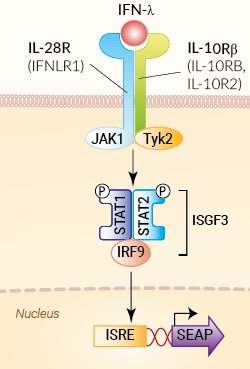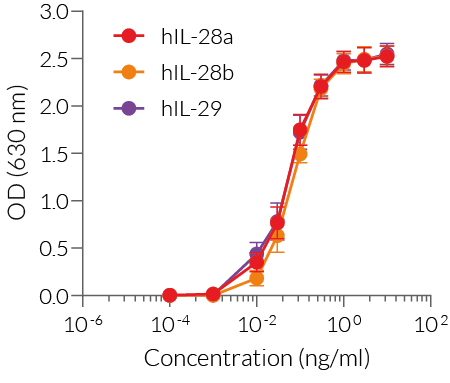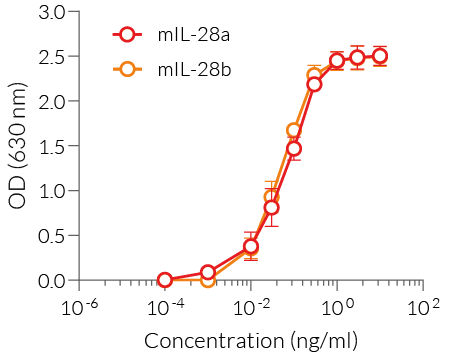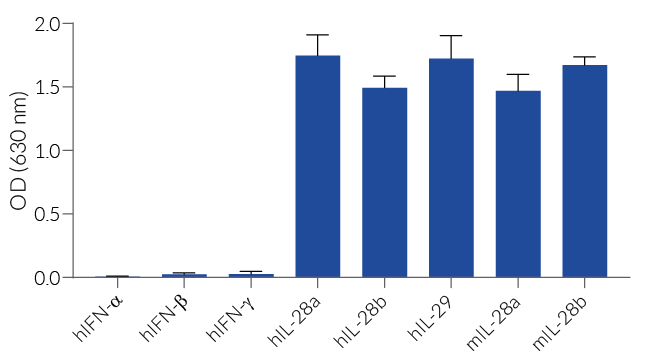IFN-λ Reporter HEK 293 Cells
| Product | Unit size | Cat. code | Docs. | Qty. | Price | |
|---|---|---|---|---|---|---|
|
HEK-Blue™ IFN-λ Cells Interferon-lambda Reporter Cells |
Show product |
3-7 x 10e6 cells |
hkb-ifnlv2
|
|
||
|
HEK-Blue™ IFN-λ vial Additional cell vial |
Show product |
3-7 x 10e6 cells |
hkb-ifnlv2-av
|
Notification: Reference #hkb-ifnlv2-av can only be ordered together with reference #hkb-ifnlv2.
Human Type III IFNs Reporter Cells
HEK-Blue™ IFN-λ cells were engineered from the human embryonic kidney HEK 293 cell line to detect bioactive human type III interferons (IFN-λs) by monitoring the activation of the JAK/ISGF3 pathway. In addition, these cells can be used for screening antibodies or small molecule inhibitors targeting the IFN-λ pathway.

Signaling pathway in HEK-Blue™ IFN-λ Cells
The human IFN-λ family comprises four distinct proteins called IFN-λ1 (interleukin-29, IL-29), IFN-λ2 (IL-28A), IFN-λ3 (IL-28B), and the poorly secreted IFN-λ4. IFN-λs are essential to the anti-viral response at epithelial barriers [1, 2].
Cell line description
HEK-Blue™ IFN-λ cells were generated by stable transfection with the genes encoding the human IFN-λ receptor (IFNLR and IL10R chains), STAT2 and IRF9, to obtain a fully active type I IFN signaling pathway. The other genes of the pathway (JAK1, TyK2, and STAT1) are naturally expressed by these cells. HEK-Blue™ IFN-λ cells were also stably transfected with the secreted embryonic alkaline phosphatase (SEAP) reporter under the control of the ISG54 promoter. This promoter comprises IFN-stimulated response elements (ISRE) that are recognized by the ISGF3 (STAT1/STAT2/IRF9) complex. The binding of IFN-λ to its receptor triggers a signaling cascade leading to the activation of ISGF3 and the subsequent production of SEAP. This can be readily assessed in the supernatant using QUANTI-Blue™ Solution, a SEAP detection reagent.
HEK-Blue™ IFN-λ cells respond to human and/or murine IL-28A and IL-28B, and human IL-29. Of note, these cells do not respond to either type I IFNs (IFN-α/β) or type II IFN (IFN-γ) (see figures).
Key Features
- Fully functional IFN-λ signaling pathway
- Readily assessable ISGF3-inducible SEAP reporter activity
- Strong response to human and murine IFN-λ
- No response to IFN-α/β (type I IFNs) and IFN-γ (type II IFNs)
Applications
- Detection of human and murine IFN-λ
- Quantification of IFN-λ activity in biological samples, such as plasma or serum [3]
- Screening of anti-IFN-λ and anti-IFNLR antibodies
- Screening of small molecule inhibitors of the IFN-λ pathway
Note: A new clone is provided with an improved Type III IFN response. The cat code has been changed accordingly (hkb-ifnlv2).
References:
1. Lazear HM. et al., 2015. Interferon-λ: Immune Functions at Barrier Surfaces and Beyond. Immunity. 43(1):15-28.
2. Lee S. & Baldridge MT., 2017. Interferon- Lambda: A Potent Regulator of Intestinal Viral Infections. Front Immunol. 8:749.
3. Gómez-Bañuelos E, et al., 2024. Uncoupling interferons and the interferon signature explain clinical and transcriptional subsets in SLE. medRxiv. 2023.08.28.23294734
Specifications
Antibiotic resistance: Blasticidin, Puromycin, Zeocin®
Growth medium: DMEM, 4.5 g/l glucose, 2 mM L-glutamine, 10% (v/v) heat-inactivated fetal bovine serum, 100 U/ml penicillin, 100 µg/ml streptomycin, 100 µg/ml Normocin®
Specificity: Detects human and mouse IL-28a (IFN-λ2), human and mouse IL-28b (IFN-λ3), and human IL-29 (IFN-λ1)
Detection range:
- Detection range for human (h) IL-28a (IFN-λ2), hIL-28b (IFN-λ3), hIL-29 (IFN-λ1): 0.01 ng/ml - 10 ng/ml
- Detection range for murine (m) IL-28a (IFN-λ2) and mIL-28b (IFN-λ3): 0.01 ng/ml - 10 ng/ml
Quality Control:
- SEAP reporter activity in response to IFN-λ is validated using functional assays.
- The stability for 20 passages following thawing is confirmed.
- These cells are tested for mycoplasma contamination.
Contents
- 1 vial containing 3-7 x 106 cells
- 1 ml of Blasticidin (10 mg/ml)
- 1 ml of Puromycin (10 mg/ml)
- 1 ml of Zeocin® (100 mg/ml)
- 1 ml Normocin® (50 mg/ml)
- 1 ml of QB reagent and 1 ml of QB buffer (sufficient to prepare 100 ml of QUANTI-Blue™ Solution, a SEAP detection reagent)
![]() Shipped on dry ice (Europe, USA, Canada, and some areas in Asia)
Shipped on dry ice (Europe, USA, Canada, and some areas in Asia)
Details
The IFN-λ family is essential to the antiviral response at epithelial barriers [1,2]. In humans, this family comprises four distinct proteins called IFN-λ1 (interleukin-29, IL-29), IFN-λ2 (IL-28A), IFN-λ3 (IL-28B), and the poorly secreted IFN-λ4. In mice, two functional orthologs (IL-28A and IL-28B) have been described. IFN-λs are produced when a viral infection is sensed by pattern recognition receptors. IFN-λs bind to a heterodimeric receptor formed by the assembly of IFNLR1 and IL10Rβ. This leads to the recruitment of the Janus kinases, JAK1 and TyK2, and phosphorylation of STAT1 and STAT2, which then dimerize and interact with IFN regulatory factor 9 (IRF9), forming the ISGF3 complex. ISGF3 binds to IFN-stimulated response elements (ISRE) in the promoters of IFN-stimulated genes (ISG) to regulate their expression.
1. Lazear HM. et al., 2015. Interferon-λ: Immune Functions at Barrier Surfaces and Beyond. Immunity. 43(1):15-28.
2. Lee S. & Baldridge MT., 2017. Interferon- Lambda: A Potent Regulator of Intestinal Viral Infections. Front Immunol. 8:749.












